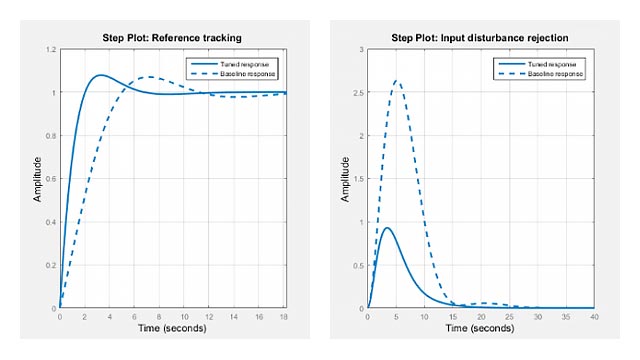边距目标
Purpose
使用时强制执行指定的增益和相位边距Control System Tuner。
描述
边距目标uses the notion of disk margin to enforce specified gain and phase margins on SISO or MIMO feedback loops. Disk margins provide a more complete picture of robust stability as they take into account all frequency and loop interactions. Therefore, disk-based margins provide a stronger guarantee of stability than the classical gain and phase margins.
For SISO feedback loops, the disk-based gain and phase margins are typically smaller but similar to the classical gain and phase margins.
对于MIMO反馈循环,基于磁盘的边距对于循环交互来说,并且可以小于经典环路 - AT-A-a-a-a-a时间增益和相位利润。基于磁盘的边距保证了所有反馈渠道的增益或相变的稳定性。增益或阶段可以同时在所有信道中改变,并且每个通道中的不同量。
For information about disk margins, seeStability Analysis Using Disk Margins(强大的控制工具箱)。

在Control System Tuner,绘图上的阴影区域表示频域中的区域,其中不满足边距目标。有关解释此情节的更多信息,请参阅控制系统调谐中的稳定性边距。
Creation
在里面调整标签Control System Tuner, select新进球>最小稳定性边距to create a Margins Goal.
Command-Line Equivalent
When tuning control systems at the command line, use调整Goal.Marginsto specify a stability margin goal.
Feedback Loop Selection
使用对话框的此部分以指定要测量稳定性边距的信号位置。您还可以指定用于评估调整目标的其他循环开放位置。
Measure stability margins at the following locations
在模型中选择一个或多个信号位置,以计算和约束稳定性边距。要约束SISO循环,请选择单值的位置。例如,为了在命名的位置限制稳定性边距
'是',点击 Add signal to list和select
Add signal to list和select'是'。To constrain a MIMO loop, select multiple signals or a vector-valued signal.Measure stability margins with the following loops open
Select one or more signal locations in your model at which to open a feedback loop for the purpose of evaluating this tuning goal. The tuning goal is evaluated against the open-loop configuration created by opening feedback loops at the locations you identify. For example, to evaluate the tuning goal with an opening at a location named
'X',点击 Add signal to list和select
Add signal to list和select'X'。
Tip
To highlight any selected signal in the Simulink®model, click![]() 。To remove a signal from the input or output list, click
。To remove a signal from the input or output list, click![]() 。当您选择多个信号时,您可以使用它们重新排序
。当您选择多个信号时,您可以使用它们重新排序![]() 和
和![]() 。For more information on how to specify signal locations for a tuning goal, seeSpecify Goals for Interactive Tuning。
。For more information on how to specify signal locations for a tuning goal, seeSpecify Goals for Interactive Tuning。
Desired Margins
使用对话框的此部分以指定反馈循环的最小增益和相位边距。
收益率(DB)
输入反馈循环所需的最小增益余量,作为DB中的标量值。
Phase margin (degrees)
Enter the required minimum phase margin for the feedback loop as a scalar value expressed in degrees.
Options
使用该对话框的此部分以指定稳定保证金目标的其他特征。
Enforce goal in frequency range
将调整目标的执行限制为特定频段。将频段指定为表单的行向量
[min,max], expressed in frequency units of your model. For example, to create a tuning goal that applies only between 1 and 100 rad/s, enter[1,100]。默认情况下,调谐目标在所有频率下适用于连续时间,并且直接达到离散时间的奈奎斯特频率。有关稳定性保证金要求的最佳效果,请挑选在增益交叉频率的每侧延伸的频带大约十年。
D scaling order
This value controls the order (number of states) of the scalings involved in computing MIMO stability margins. Static scalings (scaling order 0) are used by default. Increasing the order may improve results at the expense of increased computations. If the stability margin plot shows a large gap between the optimized and actual margins, consider increasing the scaling order. See控制系统调谐中的稳定性边距。
申请目标
立即调谐多个模型时使用此选项,例如通过在不同的操作点或块参数值下线性化Simulink模型而获得的模型数组。金宝app默认情况下,为所有型号强制强制执行主动调整目标。要为数组中的模型子集执行调整要求,请选择只有模特。Then, enter the array indices of the models for which the goal is enforced. For example, suppose you want to apply the tuning goal to the second, third, and fourth models in a model array. To restrict enforcement of the requirement, enter
2:4在里面只有模特text box.For more information about tuning for multiple models, see强大的调整方法(强大的控制工具箱)。
算法
When you tune a control system, the software converts each tuning goal into a normalized scalar valuef(x). Here,xis the vector of free (tunable) parameters in the control system. The software then adjusts the parameter values to minimizef(x)或开车f(x) below 1 if the tuning goal is a hard constraint.
For边距目标,f(x) is given by:
S=D–1[I–L(s,x)–1D是缩放的灵敏度函数。
L(s,x) is the open-loop response being shaped.
Dis an automatically-computed loop scaling factor.
α.是从指定的增益和相位裕度计算的标量参数。
这个调优目标强加了一个隐式stability constraint on the closed-loop sensitivity function measured at the specified, evaluated with loops opened at the specified loop-opening locations. The dynamics affected by this implicit constraint are the稳定的动力学for this tuning goal. The最低衰减率和Maximum natural frequency调整选项控制这些隐式受限的动态上的较低和上限。如果优化无法满足默认界限,或者如果默认界限与其他要求相冲突调整标签,使用调整Optionsto change the defaults.

